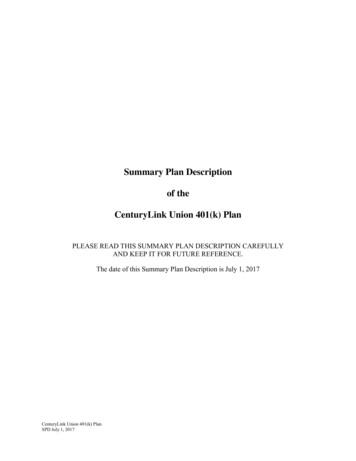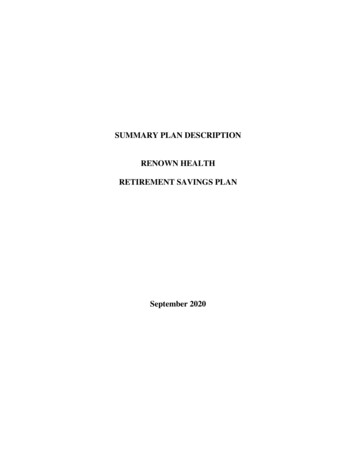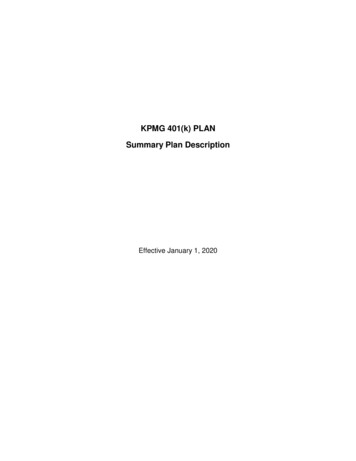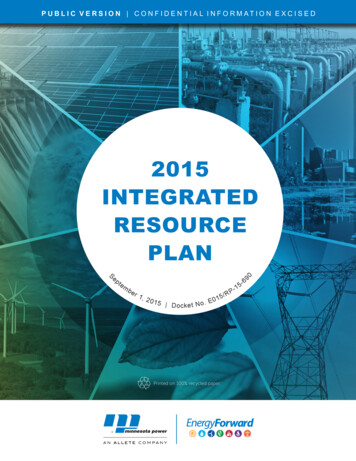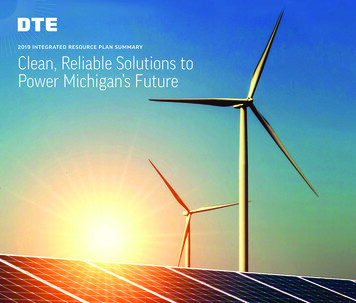
Transcription
2019 INTEGRATED RESOURCE PLAN SUMMARYClean, Reliable Solutions toPower Michigan’s FutureDTE INTEGRATED RESOURCE PLAN REPORT SUMMARYPAGE 1
IntroductionMichigan is in the midst of an energy transformation. We arereimagining and restructuring how we power our homes, ourbusinesses and our vehicles.The drivers of that transformation – a desire for safe, clean,affordable and reliable power; an aging power infrastructure;and the need to minimize our impact on the environment – eachrequire thoughtful consideration and balance.At DTE Energy – a Michigan-based company serving 2.2 millionelectric customers and 1.3 million gas customers – we have beenat the forefront of successfully striking that balance. In 2017,DTE announced plans to reduce our carbon emissions by morethan 80 percent by 2050, making it one of the most aggressiveplans in the country. And last year, we committed to producing50 percent of our energy from clean sources by 2030. Thisclean energy commitment includes a minimum of 25 percentrenewables and at least a 1.5 percent improvement in energyefficiency each year.With this integrated resource plan, we’re going even further – alot further. We’re moving up our carbon-emissions goal by afull decade, pledging to reduce emissions by 80 percent by2040. And in the near term, we have committed to a 50 percentcarbon emissions reduction by 2030¹. And we’re doing so in away that ensures our energy sources remain reliable and thepower they produce affordable.“Not only is our 80% carbonreduction goal achievable – it isachievable in a way that keepsMichigan’s power affordable andreliable. There doesn’t have to be achoice between the health of ourenvironment or the health of oureconomy; we can achieve both.”Gerry Anderson, chairman and CEO, DTE Energy1. Compared to 2005 baseline; CO2 emissions associated with energy generated for DTE Electric customers.PAGE 2DTE INTEGRATED RESOURCE PLAN REPORT SUMMARY
In order to achieve our bold new goal, we’re expanding ourenergy-efficiency programs to reduce even more consumptionand help our customers - especially our low-income customers- save energy and money. And we’ve expanded our voluntaryrenewables program, MIGreenPower, to our large business andindustrial customers, which will accelerate our state’s transitionto renewable energy and empower companies to meet theirsustainability goals through voluntary investments.We’re also moving our previously announced closures of theTrenton Channel Power Plant and the final generation unit at St.Clair Power Plant up one year, to 2022.We’re committed to our communities – to creating jobs for thepeople who live in them and to providing a balanced mix of safe,clean, reliable and affordable energy. In fact, reducing carbon isthe greatest opportunity we have as an energy company. Andwe’re already doing it – by building the clean energy sources thatour customers are asking us to build.2040We’re moving our commitment toreduce carbon emissions by 80percent forward a full decade.This integrated resource plan (IRP), submitted to the MichiganPublic Service Commission, lays out our vision for ensuringMichigan continues to lead in creating clean, reliable, affordable,home-grown energy that its residents and businesses can dependon. It provides both a high-level and detail-rich strategy forpowering Michigan’s homes and businesses over the next fiveyears, as well as a flexible long-term plan that can evolve as ourtechnological options and the needs of our state evolve.DTE INTEGRATED RESOURCE PLAN REPORT SUMMARYPAGE 3
More Clean Energy,Less CoalClimate change is one of the defining public policy issues of ourtime. At DTE, we are passionate about being central to the solution.That’s why we have set ambitious new goals of reducing carbonemissions by 80 percent by 2040 and 50 percent by 2030. Thosegoals align with the target scientists have identified as necessaryto help address climate change, and we will achieve them throughaggressive investment in energy efficiency, renewables, the BlueWater Energy Center and our voluntary renewables programs, aswell as through earlier coal retirements.Coal Plant RetirementsIn 2016, DTE announced the retirements by 2023 of three agingpower plants – River Rouge, St. Clair and Trenton Channel– thataccount for nearly 20 percent of our total generation. Thoseretirements follow the closure of two other plants – Marysville andHarbor Beach – between 2011 and 2013, and generation units atour St. Clair, Trenton Channel and River Rouge plants between 2011and 2017.We’re now planning to close our Trenton Channel Power Plant andSt. Clair Power Plant in 2022 – one year earlier than we originallyintended.1 We want to move forward as quickly as possible toachieve our carbon-reduction goal, and need to do it in a waythat balances the reliability of the energy grid while also workingclosely with the impacted communities and employees during thistransition.1PAGE 42018-2040 Generation Mix Percentage70Determined infuture IRP6050Determined infuture 40Storage*Based on current projections. Final percentages to be determined in future IRPs.Our coal plants have served our communities and employees well for nearly 75years. We’re proud of that legacy of service and will continue to build upon itfor generations to come. We are working closely with municipal leaders in RiverRouge, Trenton and St. Clair County to find meaningful ways to turn the coalplant properties into viable economic contributors after our facilities close. Weare collaborating with union leadership on developing retraining programs and anemployee transition strategy that is committed to no layoffs while maintainingaffordable and reliable 24/7 power for our customers.contingent on resolution of grid reliability concernsDTE INTEGRATED RESOURCE PLAN REPORT SUMMARY
Building RenewablesDTE is Michigan’s largest renewable-energy provider. By 2024, we willmore than double our renewable energy, generating enough clean energyto power 800,000 Michigan homes. By the time we remove all coal fromour generation fleet in 2040, our renewable-energy portfolio will havequadrupled.Since 2009, we’ve driven investments of 2.8 billion in renewable energy –a figure that will increase to 4.8 billion by 2024. The vast majority of thatinvestment is supporting Michigan communities and creating Michigan jobs.4,000Michigan jobs created2040Our renewable energywill quadruple by 2040DTE INTEGRATED RESOURCE PLAN REPORT SUMMARYPAGE 5
11.5 M11.5 million solarpanels by 2040DTE’s Renewables Mix TodaySolarDTE currently operatesmore than 30 solar parksin Michigan, with plans toincrease solar capacity by25 percent over the nextfive years. In 2017, DTEcommissioned the O’SheaSolar Park in Detroit,repurposing 10 acres ofpreviously vacant land, andthe Lapeer Solar Park, thelargest universal solar parkin the state. The Lapeersite includes 200,000 solarpanels, making it one of thelargest solar parks east ofthe Mississippi, and its arraysproduce enough clean energyto power 11,000 homes.PAGE 6Wind3131 solarparks inMichigan200K200,000solar panelsin Lapeer11K11,000homes can bepowered bythe LapeerSolar ParkWind is currently our lowestcost and most abundantrenewable resource, which iswhy we’ve already investedin the building of 14 windparks. In early 2019, DTEcommissioned Pine River,its largest operating windpark to date. Its 65 turbinesgenerate enough energy topower more than 54,000homes. Pine River will offsetnearly 300,000 metrictons of CO2 annually – thegreenhouse-gas equivalentof taking more than 63,000cars off the road. In early2020, we’ll commission anadditional wind park thatwill be even larger than PineRiver.14We’veinvestedin 14 windparks300KPine Riverwill offsetnearly300,000metric tons ofC02 annually2020In 2020 we’llcommissionan additionalwind parkDTE INTEGRATED RESOURCE PLAN REPORT SUMMARY
Improving Energy EfficiencyPartnering with Michigan Residents, Business and IndustryWe’re proud of our investment in renewables, of DTE’s leadership in this criticallyimportant area and of the fact that we align with scientific consensus about the stepsneeded to protect our planet. And we’re determined to go further.Combating climate change must be a cross-industry effort, so we’ve expanded ourMIGreenPower program to our large business and industrial customers. Introducedin 2017, MIGreenPower is a voluntary renewable energy program that provides DTE’sresidential and business customers with an easy and affordable way to reduce theircarbon footprint by increasing the percentage of their energy use attributable to localwind and solar energy sources, up to 100 percent. Participating customers – who nownumber more than 5,000 – see a slight increase in their monthly bill while knowingthey’re helping to support Michigan’s clean energy future.We’re expanding this voluntary initiative to meet the needs of our largest business andindustrial customers who are working to meet their own sustainability goals, enablingthem to invest in renewable energy, which will help drive our state toward an evencleaner future. The program is designed to grow and represents a progressive approachto fill market demand. In fact, we’ve already partnered with Ford and GM to providerenewable energy to support their sustainability goals.Ford has committed to procuring 500,000 MW hours annually of wind energy to powerseveral of its Michigan facilities, including the plant that makes its popular F-150 truck.GM has partnered with DTE to procure 300,000 MW hours annually of wind energy topower its technical center in Warren, Mich., and its headquarters in Detroit.DTE also is exploring opportunities to expand its residential offerings to those interestedin more local, community renewable energy.DTE INTEGRATED RESOURCE PLAN REPORT SUMMARYEnergy efficiency works hand-in-hand with renewableenergy sources to ensure we meet our clean energygoals. In short, when homes and businesses reduce theirenergy use, we can generate less electricity, benefitingboth customers’ pocketbooks and the environment.DTE previously committed to increasing energy efficiencyat a level equivalent to 1.5 percent of sales annually. Ourefforts already have resulted in nearly 700 MW annuallyof reduced energy demand since 2009, equivalent to theenergy produced by one large power plant. Improvingenergy efficiency also results in lower bills for customers;for every dollar invested in energy efficiency, customerssave 5.With this plan, we’re building on the success ofthese efforts by committing to a 1.75 percent annualimprovement in energy efficiency - 75 percent more thanthe level required by law. Improving energy efficiencywill reduce our carbon emissions even further – meaningwe need to generate even less energy. The expansion ofthose programs also will mean more jobs and businessfor the Michigan firms that support them.DTE also is a leader in demand response, rewardingresidential and business customers who reduce or shiftelectricity usage during peak periods. We offer ourcustomers the opportunity to reduce their energy use andlower their bills through multiple programs. Our demandresponse program is in the top 25 percent nationwideand is the largest in Michigan, with more than 700 MWof program capacity.PAGE 7
Powering Michigan’s FutureThe plan we are submitting focuses on the next five years and considers the most affordable and reliable mix of generation sources that are available today. However, thesetechnologies are improving rapidly, so we also have created a flexible long-term plan that allows us to review technological advancements as they become feasible andaffordable. We’ve developed four alternate long-term options, modeling different costs and technology assumptions for each. We will continue to revisit and refine our plan astechnology develops, customer desires and trends become more clear, and costs decline.The Defined Short Term: 2019-2024CARBON REDUCTION TARGET 32%12019COAL PLANT RETIREMENTS20202021202220232024Retire 2,000 MWof coal, or threeplants, by 20222Retire 1 generationunit at St. ClairPower PlantPLANNED 24/7 GENERATIONADDITIONSBlue WaterEnergy Centercomes on lineENERGY EFFICIENCY(ANNUAL PERCENT OF SALES)1.5%1.75%1.625%RENEWABLES(CUMULATIVE PERCENT OF SALES)12.5%15%VOLUNTARY RENEWABLES465MWActively market new programs, up to 715 MW,driven by customer demandDEMAND RESPONSE709 MWPAGE 8859 MWDTE INTEGRATED RESOURCE PLAN REPORT SUMMARY
The Flexible Future: 2025-2030The Flexible Future: 2031-2040CARBON REDUCTION TARGET 50%1CARBON REDUCTION TARGET 80%1Retire Belle River Power Plant by 2030Increase renewables to at least 25%Retire Monroe Power Plant by 2040Continue 1.75% energy efficiency and review biannuallyMaintain or increase demand responseContinue to market and add voluntary renewables based oncustomer demandIncrease renewables, energy efficiencyand demand response consistent withcarbon reduction goalsPossible pathways that could meet future generation needs:Achieve 1,390 MW of voluntaryrenewablesAchieve 1,390 MW of voluntaryrenewablesIncrease demand responseConstruct new natural gas-fueledpower plantMaintain 1.75% energyefficiencyMaintain 1.75% energy efficiencyAchieve 465 MW of voluntaryrenewablesAchieve 465 MW of voluntaryrenewablesIncrease demand responseConstruct new natural gas-fueledpower plantIncrease energy efficiency to2.00% in 2026DTE INTEGRATED RESOURCE PLAN REPORT SUMMARYMaintain 1.75% energy efficiencyThere are multiple pathways to meet carbongoals and generation needs in 2030 andbeyond; we will remain flexible and presentpotential future options in our next IRP.1. Compared to 2005 baseline; CO2 emissions associated with energy generated forDTE Electric customers2. Retirements of St. Clair, River Rouge and Trenton Channel plants are contingenton the successful start up of Blue Water Energy Center and resolution of gridreliability concernsPAGE 9
Balanced, Reliable,Customer-FocusedAs we embrace renewable energy, our IRP provides a clear andbalanced path for meeting our carbon-reduction goals whileensuring energy remains affordable and reliable.Michigan’s unique peninsular geography and the physicallimitations of the transmission system mean that 95 percent ofMichigan’s power generation must be physically located in theLower Peninsula to meet regional capacity reliability standards.So while some power can be imported from out of state, the vastmajority must be locally produced in order to maintain a reliableenergy grid.Even as three coal plants are going away, the demand foraround-the-clock electricity is not. And since the weather and theeconomy are both prone to change, we need a flexible, nimblemix of energy sources that can meet our customers’ changingneeds, 24 hours a day, seven days a week. Because renewableenergy is variable, the need to carefully plan for and balance localsupply for every hour of the year is absolutely critical. We cannotrely on purchasing energy on the market when demand is high –if every energy company in our region did that, reliability wouldbe undermined. That’s why we’re pushing hard to both meet ourambitious clean-energy goals and to ensure our regional energygrid remains reliable.Key to balancing these commitments are the Blue Water EnergyCenter and the Ludington Pumped Storage Power Plant.PAGE 10DTE INTEGRATED RESOURCE PLAN REPORT SUMMARY
850KBlue Water Energy CenterNatural gas will help us make the transition to renewables in a way that provides the reliability Michigan residentsneed, while significantly reducing our carbon footprint. Natural gas plants are a highly efficient, low-emissionenergy source that provide reliable, on-demand, 24/7 electricity.In 2022 BWEC willprovide enoughenergy to power850,000 homesThe Blue Water Energy Center (BWEC), approved by the Michigan Public Service Commission in 2018, will be astate-of-the-art, natural gas combined-cycle plant and one of the most efficient plants in the United States. It willreplace three retiring coal plants, allowing Michigan to have both a sharp reduction in carbon emissions and analways-available energy source, helping us create a cleaner energy future. It will be capable of ramping up quicklyto accommodate changes in demand and fluctuations in renewables and other energy sources, ensuring our state’shomes and businesses have a reliable power source and giving them peace of mind.This plant will provide enough 24/7, affordable and reliable energy to power 850,000 homes beginning in 2022.BWEC will reduce CO2 emissions by 70 percent compared with the three coal plants it is replacing. It also willreduce sulfur dioxide (SO2), and nitrous oxide (NOx) emissions by more than 95 percent compared with the coalplants slated for retirement, while supporting Michigan’s manufacturing operations and residential customers.The plant represents a nearly 1 billion investment in Michigan. Construction jobs will peak at about 520 full-timepositions during construction and will provide about 35 full-time positions once the plant is in operation.DTE INTEGRATED RESOURCE PLAN REPORT SUMMARYPAGE 11
Ludington Pumped Storage Power PlantThe Ludington Pumped Storage Power Plant, whichDTE co-owns with Consumers Energy, is located ona 1,000-acre site on Lake Michigan in Mason County.The plant generates hydroelectric power and supportsour renewables generation because it acts like a giantbattery that can be tapped when renewable outputdrops.The Ludington plant consists of a man-made reservoirlocated above six 300-ton turbines. The reversibleturbines work as pumps when energy is plentifuland low-cost, such as when the sun is shiningand the wind is blowing, and as power generatorswhen demand is higher and renewable sources lessabundant. The plant pumps water from Lake Michiganuphill to the 27 billion-gallon reservoir at low-demandtimes, and releases the stored water downhill throughthe turbines to generate electricity when energydemand is higher.Ludington can ramp up to peak output in just 30minutes. It provides a sustainable, clean, reliableenergy source that quickly responds to the daily,weekly and seasonal highs and lows of Michigan’senergy demand. It also helps keep energy billslower because it allows DTE to avoid having to buyexpensive out-of-state electricity when demand peaks.An 800 million upgrade project to replace each of thesix turbines is on schedule to be completed in 2020.Ludington, the second-largest pumped storage facilityin the United States, will then support power for175,000 DTE households.PAGE 12 800MAn 800 millionupgrade project toreplace each of the sixturbines is on scheduleto be completed in2020DTE INTEGRATED RESOURCE PLAN REPORT SUMMARY
DTE INTEGRATED RESOURCE PLAN REPORT SUMMARYPAGE 13
A Collaborative Vision:Stakeholder InputWe must work together collaboratively to secure Michigan’senergy future. DTE spent months seeking input on this IRP frommembers of the public, consumer and environmental advocates,and other stakeholders at numerous forums and open housesacross the state.We believe everyone benefits from the exchange of informationand open dialogue, and so we worked to implement acomprehensive, transparent and participatory stakeholderengagement process. Outreach was designed to create awarenessof the IRP process, encourage honest communication, and obtainand incorporate feedback. We hosted four technical workshopsand three public open houses, and created a DTE IRP emailaccount for electronic comment submission and response.Registration for the open houses was not required, and wepublicized them through social media, the DTE newsroom, emailsto stakeholders and through our blog, EmpoweringMichigan.com. Wealso included open house content on the site for easy access.PAGE 14DTE INTEGRATED RESOURCE PLAN REPORT SUMMARY
At each technical meeting and open house, we worked to understand and respond to stakeholdersuggestions and concerns. Here’s what we heard at those meetings: Michiganders want their power sources to be safe, affordable and reliable. They care about climate issues and want to make sure we’re doing everything we can to transitionto cleaner energy, including renewable energy, energy efficiency and demand response. They want more information on how to engage with DTE on everything from energy-efficiencyaudits to tree trimming.DTE has listened carefully to that input. We are confident this IRP incorporates the needs and concernsof Michigan residents and businesses and provides a safe, affordable, reliable and effective course ofaction.We appreciate the participation and feedback that was provided and engagement from our technical andpublic stakeholders. We will continue to communicate with our stakeholders as part of our commitmentto engagement.DTE INTEGRATED RESOURCE PLAN REPORT SUMMARYPAGE 15
For more information visit: www.journeyto80.com
At DTE Energy - a Michigan-based company serving 2.2 million electric customers and 1.3 million gas customers - we have been at the forefront of successfully striking that balance. In 2017, DTE announced plans to reduce our carbon emissions by more than 80 percent by 2050, making it one of the most aggressive plans in the country.

